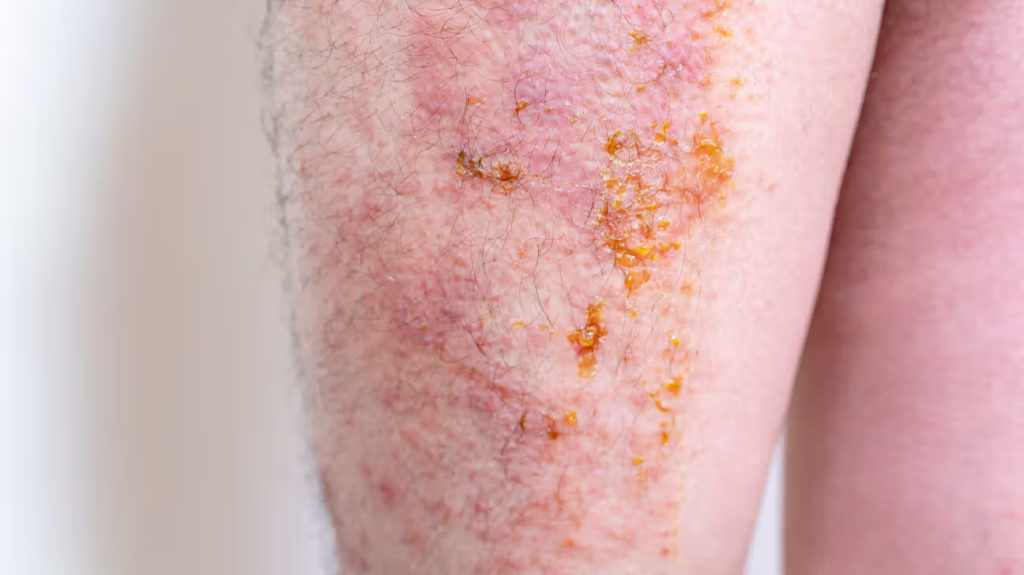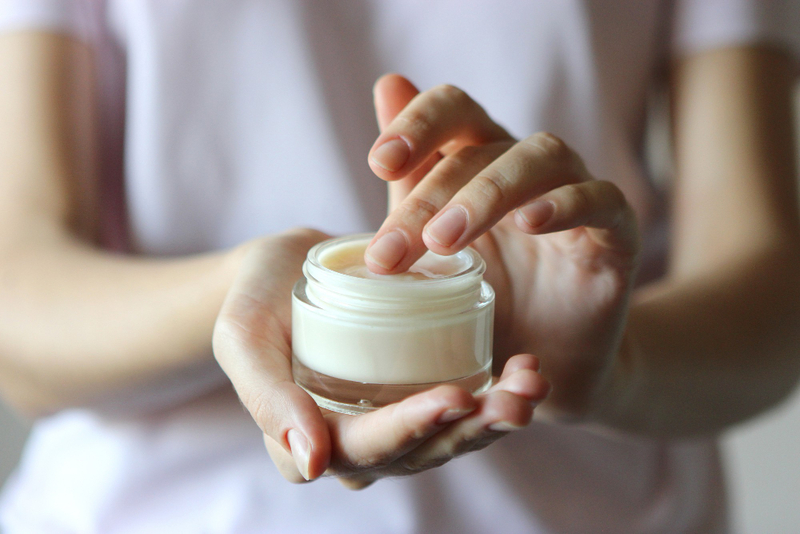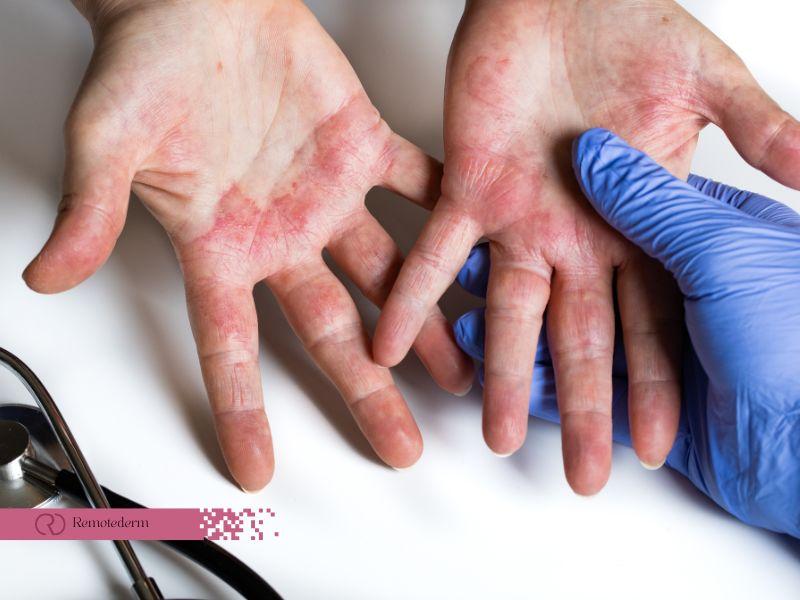Eczema is a common skin condition that affects millions of people worldwide, including many in Canada. Among its various forms, weeping eczema stands out as a particularly challenging subtype. Characterized by oozing, crusting, and intense itching, weeping eczema can significantly impact a person’s quality of life. In this comprehensive guide, we delve into the causes, symptoms, and treatment options for weeping eczema, offering valuable insights and practical advice for managing this condition effectively.
What is Weeping Eczema?
Weeping eczema, also known as wet eczema or exudative eczema, is a severe form of dermatitis characterized by the presence of fluid-filled blisters, oozing, and crusting. It often occurs in individuals with a history of eczema or atopic dermatitis, but it can also manifest independently.
What Does Weeping Eczema Look Like?
Weeping eczema typically presents as red, inflamed patches of skin with fluid-filled blisters or vesicles. The affected area may appear moist, oozing, and crusted, with intense itching and discomfort.

Symptoms of Weeping Eczema
Identifying the symptoms of weeping eczema is crucial for accurate diagnosis and treatment. This subtype of eczema often presents with a distinctive set of signs and discomforts, which include:
- Intense Itching and Burning Sensation: Constant itching combined with a burning feeling is one of the main signs of weeping eczema. The overwhelming urge to scratch can aggravate the affected skin and cause more irritation and inflammation.
- Redness and Inflammation of the Skin: The affected area typically exhibits pronounced redness and inflammation, signaling the body’s inflammatory response to the underlying skin condition. The skin may appear visibly irritated and inflamed, with heightened sensitivity to touch.
- Formation of Fluid-Filled Blisters or Vesicles: Weeping eczema often manifests as fluid-filled blisters or vesicles on the surface of the skin. These blisters may vary in size and can be surrounded by red, inflamed skin. As the condition progresses, the blisters may rupture, resulting in oozing and crusting.
- Oozing, Crusting, and Scaling of the Affected Area: As the blisters rupture, the affected area may ooze a clear or yellowish fluid, leading to the formation of crusts and scales. The skin may feel rough and uneven to the touch, and the presence of crusts can exacerbate itching and discomfort.
Causes of Weeping Eczema
Weeping eczema can stem from a multitude of factors, each contributing to the exacerbation of this challenging skin condition. Understanding these triggers is essential for effectively managing and mitigating flare-ups. Some common causes of weeping eczema include:
- Skin Irritation from Harsh Chemicals or Detergents: Exposure to harsh chemicals present in detergents, soaps, household cleaners, and personal care products can irritate the skin and trigger an inflammatory response, leading to weeping eczema in susceptible individuals.
- Allergic Reactions to Certain Substances or Foods: Allergens present in the environment or ingested through food can provoke allergic reactions in individuals predisposed to eczema. Common allergens include pollen, pet dander, dust mites, certain foods, and latex. These allergens can instigate an immune response, resulting in inflammation and the development of weeping eczema lesions.
- Excessive Scratching or Rubbing of the Affected Area: Persistent scratching or rubbing of the skin can exacerbate inflammation and disrupt the skin barrier, making it more susceptible to infection and weeping eczema. The urge to scratch often intensifies during flare-ups, leading to a vicious cycle of itching, scratching, and further skin damage.
- Environmental Factors such as Humidity or Temperature Changes: Environmental factors play a significant role in triggering eczema flare-ups, including weeping eczema. Changes in humidity levels, exposure to extreme temperatures, and dry air—common in parts of Canada—can parch the skin, exacerbating dryness and irritation. Additionally, factors such as sweating and prolonged exposure to water can further aggravate symptoms in individuals prone to weeping eczema.
Treatment Options for Weeping Eczema
Managing weeping eczema involves various treatments to reduce inflammation, relieve itching, and promote healing:
- Topical Corticosteroids: These medications reduce inflammation and itching, offering rapid relief when applied to affected areas.
- Emollients and Moisturizers: Hydrate the skin and prevent dryness, restoring the skin’s natural barrier function and promoting healing over time.
- Oral Antihistamines: Alleviate itching and promote sleep, helping individuals with weeping eczema achieve better rest and comfort.
- Wet Dressings or Compresses: Soothe irritated skin and promote healing, providing immediate relief and enhancing the effectiveness of topical treatments.
- Avoidance of Triggers: Stay away from allergens and irritants, minimizing the risk of flare-ups and reducing the severity of symptoms over time.

Seeking guidance from an online eczema dermatologist allows individuals to customize treatments for maximum relief and skin well-being. This ensures personalized care and effective management strategies tailored specifically for those experiencing weeping eczema.
How to Dry Up Weeping Eczema
Drying up weeping eczema requires gentle care and proper skin care practices. Consider the following tips:
- To remove extra moisture, gently pat the affected area with a clean, soft towel.
- Steer clear of scratching or rubbing the skin as this can exacerbate oozing and irritation.
- Apply a thin layer of topical corticosteroid ointment or cream to aid in healing and reduce inflammation.
- Affected areas should be kept cool and dry, and constricting or tight clothing should be avoided.
Final Thoughts
Living with weeping eczema in Canada can be challenging, but relief is possible with proper treatment and self-care. Understanding triggers and seeking guidance from a dermatologist—whether in person or through Canada’s telehealth platforms—are essential steps in managing symptoms and improving quality of life. By reducing stress, maintaining healthy habits, and avoiding known triggers, Canadians can better cope with the challenges of weeping eczema and enjoy improved skin comfort and well-being. With the support of Canada’s robust healthcare resources, individuals can take control of their skin health and find effective relief from this condition.
FAQs
1. Can stress trigger weeping eczema?
Yes, It’s true that stress can make eczema symptoms worse, especially crying eczema. Symptoms may be lessened by practicing mindfulness, relaxation techniques, and stress-relieving hobbies.
2. Is weeping eczema contagious?
No, weeping eczema is not contagious. It is a non-infectious skin condition caused by inflammation and immune system dysfunction.
3. Are there specific foods to avoid with weeping eczema?
While food allergies or sensitivities can trigger eczema flare-ups in some individuals, there’s no universal list of foods to avoid. Keeping a food diary and consulting with a healthcare professional can help identify potential triggers.
4. Can weeping eczema be cured completely?
While there is no known cure for eczema, including weeping eczema, symptoms can often be managed effectively with proper treatment and skincare practices. Long-term management strategies aim to reduce flare-ups and improve quality of life.
